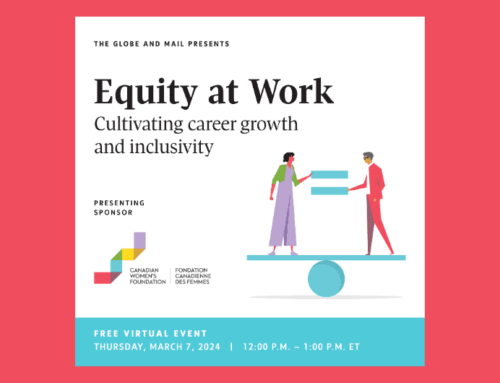Is the gender pay gap a product of women’s own choices?
That’s one of the enduring myths about the disparity between male and female earnings — that it primarily results from women’s choices to structure their careers around having children. Or because they choose careers in less lucrative fields than men.
This was the key argument of a recent Financial Post column titled “There’s only one main reason a wage gap exists: Call it motherhood” (Aug. 14, 2018). But if we chalk the gender pay gap up to women’s choices and dismiss the need for social and systemic change, we’ll never close it.
The motherhood penalty is a crucial factor, but it’s not the only one in the gender pay gap. Contrary to studies cited in the column, even women without children face a pay gap of 10% according to Statistics Canada data from 2015.
Playing up the motherhood penalty also ignores barriers that women face in the workplace whether they have children or not – particularly when they do pursue careers in male-dominated arenas. And even before the #MeToo Movement hit the headlines in late 2017, there were many reports about sexual harassment and gender discrimination in policing, military, firefighting, and STEM professions. These barriers discourage more women from entering male-dominated fields and encourage women already in them to drop out – it’s been dubbed “the leaky pipeline.”
But back to the motherhood penalty: let’s ask ourselves why it exists and whether it is acceptable that mothers pay a price for pursuing a career and a family. According to a recent UBC study, white men in Canada actually earn more when they become fathers.
“The idea is that we have a gender wage gap because women are choosing to be in ‘less stressful’ or ‘less demanding’ jobs so that they can take over family responsibilities,” says Sarah Kaplan, Director of the Institute for Gender and the Economy, in an interview with the Canadian Women’s Foundation last year. “But what most people don’t recognize is that there are structural forces shaping that ‘choice’ women make,” Kaplan says.
So what are these structural forces that shape women’s “choices”?
Lack of affordable, accessible, quality daycare: This is a key reason many women either have to scale their jobs back or leave the work force. About 44% of Canadian non-school-aged children live in “childcare deserts”, which are areas where at least three children would be in potential competition for each licensed daycare space, according to a 2018 report by the Canadian Centre for Policy Alternatives. The steep cost of daycare and limited spaces in Toronto and Vancouver have been linked to a higher gender employment gap in these cities, meaning that fewer women are in the work force. The government needs to address this by prioritizing affordable, accessible, quality childcare.
Traditional gender roles around unpaid work: Women aged 25 to 54 spend 1.5 hours more than men on unpaid housework. On a given day, women are three times more likely than men to provide care to an adult family member or friend, reports Statistics Canada. Families need to address these imbalances by equally sharing the burden of unpaid and undervalued domestic work. Governments and workplaces can also provide a more supportive environment for fathers to take parental leave: while 46.8% of women aged 25 to 54 took at least one maternity leave, 3.8% of men took parental leave.
Lack of pay equity: “Female‑dominated occupations tend to be compensated at lower wage rates than male‑dominated occupations — even when they involve the same skill level,” according to Statistics Canada. For example, 97% of truck drivers in Canada are men and earn a median salary of $45,417 per year, while 97% of early childhood educators are women and earn a median salary of $25,334 per year, according to a Canadian Centre for Policy Alternatives Report. Efforts to achieve pay equity recognize this and aim to “close the part of the wage gap that is due to gender discrimination in employer pay practices.”
Lack of equal pay and pay transparency: While pay equity compares value and pay of different jobs, equal pay compares pay of similar jobs. Pay transparency – which involves requiring employers to disclose existing pay structures – is one way to determine whether those performing the same jobs are being paid equally. Recently, a few Canadian universities recognized that women faculty members weren’t being paid as much as their male counterparts and gave the women raises. While it’s true that, within the same roles, some employees may receive a higher salary due to factors including performance and seniority, there are problems with the meritocracy we live in.
As Sarah Kaplan points out, “the people that have risen to the top have worked hard, there’s no question. But they want to believe they’re there for their own unique talents and skills, and they don’t want to believe they benefitted somehow from the tailwinds provided by privilege … People all like to think they worked hard for their position without understanding how much harder a person of colour, an Indigenous person, a new Canadian, a woman, someone with a disability, would have to work to get to the same place.” Stronger pay transparency legislation is one way to help make existing pay gaps visible.
Closing the pay gap is about societal and systemic choices, not women’s choices. It’s up to society to prioritize childcare, balance unpaid housework, and advance pay equity, equal pay, and pay transparency so that women aren’t paying the penalty.
Learn More:
- 5 Ways Gender Equality Benefits Everyone
- Closing the Gender Pay Gap: Canada’s Pay Gap Means Women Effectively Work for Free for the Rest of the Year
- Addressing Gender-Based Violence Helps Close the Gender Pay Gap
Take Action:
- Sign up for our e-newsletter to have our latest stories and resources sent to your inbox.
- Follow us on Facebook and Twitter to join a national conversation about empowering girls.






[…] No, Moms, the gender pay gap is not on us […]
[…] Confidence-Boosting Books for Girls No, Moms, the gender pay gap is not on us 6 Ways to Raise Confident Girls: Tips from Canadian Women’s Foundation […]